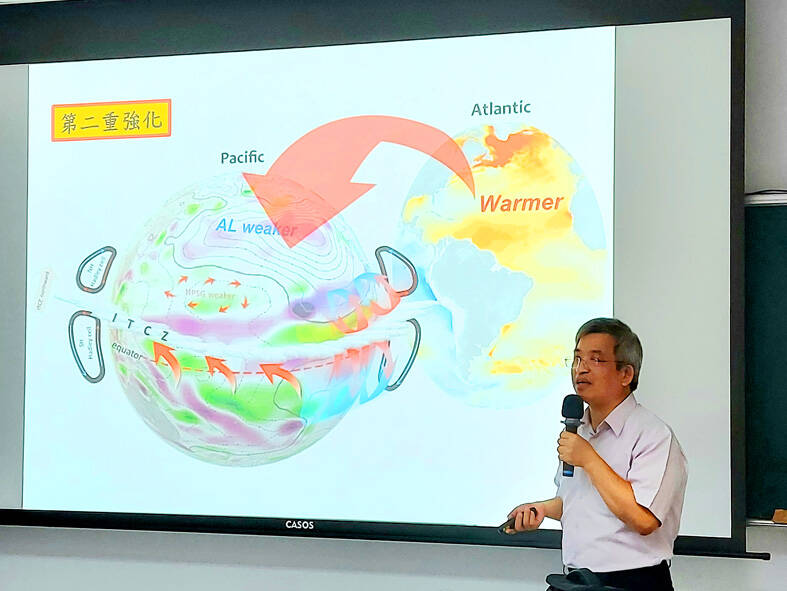Super typhoons in winter are more likely to occur when the solar cycle is amplified by atmospheric and ocean interactions, National Taiwan Normal University researchers said on Tuesday.
Wu Chau-ron (吳朝榮), a professor at the university’s Department of Earth Science, said his team found that solar activity could induce typhoons or even super typhoons in the off-season, despite the lower sea surface temperature.
The study, which was jointly conducted by Wu’s team and a team led by Yu Jin-yi (余進義), professor of Earth System Science at the University of California, Irvine, collected tracking data for 402 off-season super typhoons in the western North Pacific from 1945 to 2018.

Photo: CNA
Based on their findings, the occurrence of super typhoons outside the normal typhoon season can result in devastating loss of life and property damage, Wu said.
An example of this type of super typhoon was Typhoon Haiyan in 2013, Wu added.
The study looked into the three conditions that enhance the chance of off-season typhoons occuring, the first being the solar cycle, Wu said.
Every 11 years, the sun’s magnetic poles change their polarity, and the Earth gains more momentum, heating up the tropopause, which causes the Hadley cell and northeast trade winds to weaken, he said.
Second, atmospheric conditions, such as global warming, strengthen the connection between subtropical and tropical zones, which increases the relationship between the solar cycle and the formation of typhoons, Wu said.
Third, the ocean-atmosphere interaction heats up the northeastern Pacific and that warmth reaches the central Pacific, which reduces the Walker cell and results in deep ocean circulations moving east, he said.
Such interaction also weakens the vertical wind shear in a way that facilitates the formation of off-season typhoons, he added.
As typhoons are formed further east in the off-season and there is a lack of steer flow, they move more slowly, which means more energy and water are absorbed from the ocean, increasing the probability of a super typhoon forming, Wu said.
As the Earth faces an active solar period over the next two years, the likelihood of super typhoons occurring is greater and people should be vigilant, he said.
The study was published in the npj Climate and Atmospheric Science journal on Oct. 20.

An essay competition jointly organized by a local writing society and a publisher affiliated with the Chinese Communist Party (CCP) might have contravened the Act Governing Relations Between the People of the Taiwan Area and the Mainland Area (臺灣地區與大陸地區人民關係條例), the Mainland Affairs Council (MAC) said on Thursday. “In this case, the partner organization is clearly an agency under the CCP’s Fujian Provincial Committee,” MAC Deputy Minister and spokesperson Liang Wen-chieh (梁文傑) said at a news briefing in Taipei. “It also involves bringing Taiwanese students to China with all-expenses-paid arrangements to attend award ceremonies and camps,” Liang said. Those two “characteristics” are typically sufficient

A magnitude 5.9 earthquake that struck about 33km off the coast of Hualien City was the "main shock" in a series of quakes in the area, with aftershocks expected over the next three days, the Central Weather Administration (CWA) said yesterday. Prior to the magnitude 5.9 quake shaking most of Taiwan at 6:53pm yesterday, six other earthquakes stronger than a magnitude of 4, starting with a magnitude 5.5 quake at 6:09pm, occurred in the area. CWA Seismological Center Director Wu Chien-fu (吳健富) confirmed that the quakes were all part of the same series and that the magnitude 5.5 temblor was

The brilliant blue waters, thick foliage and bucolic atmosphere on this seemingly idyllic archipelago deep in the Pacific Ocean belie the key role it now plays in a titanic geopolitical struggle. Palau is again on the front line as China, and the US and its allies prepare their forces in an intensifying contest for control over the Asia-Pacific region. The democratic nation of just 17,000 people hosts US-controlled airstrips and soon-to-be-completed radar installations that the US military describes as “critical” to monitoring vast swathes of water and airspace. It is also a key piece of the second island chain, a string of

The Central Weather Administration has issued a heat alert for southeastern Taiwan, warning of temperatures as high as 36°C today, while alerting some coastal areas of strong winds later in the day. Kaohsiung’s Neimen District (內門) and Pingtung County’s Neipu Township (內埔) are under an orange heat alert, which warns of temperatures as high as 36°C for three consecutive days, the CWA said, citing southwest winds. The heat would also extend to Tainan’s Nansi (楠西) and Yujing (玉井) districts, as well as Pingtung’s Gaoshu (高樹), Yanpu (鹽埔) and Majia (瑪家) townships, it said, forecasting highs of up to 36°C in those areas